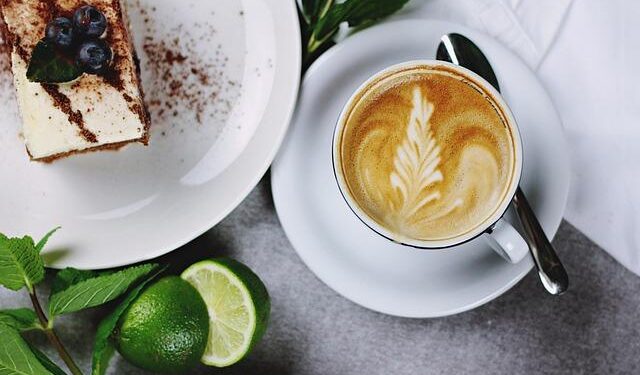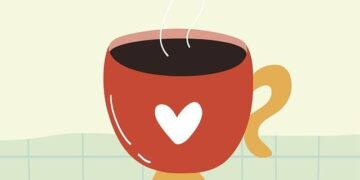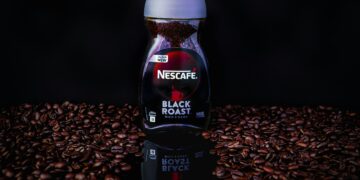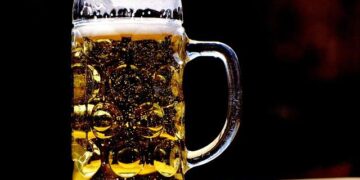Table of Contents
Introduction: The Daily Ritual and the $0.80 Question
It’s a familiar morning ritual for Maya, a composite character of a loyal, millennial Starbucks customer.
Rushing to her next meeting, she pulls out her phone to order her daily Grande Iced Brown Sugar Oatmilk Shaken Espresso.
The muscle memory is strong: tap, customize, pay.
But today, something catches her eye.
The price has jumped.
It’s not just the base cost; it’s a new, explicit $0.80 charge for the brown sugar syrup she swaps in every day.1
The total comes to $7.57.3
This small but jarring charge becomes the catalyst for a larger inquiry: What is this $7.57 really buying? Is the “promise” of Starbucks—the quality, the experience, the status—still worth the price?
Maya’s moment of hesitation is not isolated.
It reflects a growing tension between the coffee giant and its customers.
Online forums are replete with frustration, with users calling the prices “unacceptable” and “insane”.1
This sentiment is beginning to register on the company’s bottom line.
In its 2024 fiscal year, Starbucks saw a 2% drop in North American sales at stores open for at least a year, a clear signal that price sensitivity is becoming a significant business headwind.5
The price of a Starbucks iced coffee is no longer a simple transaction; it has become a complex, and increasingly fragile, negotiation between tangible costs, sophisticated psychological pricing, a shifting brand promise, and the consumer’s own mental calculus.
This report deconstructs that negotiation.
The sticker shock is not just a feeling; it is a documented reality of the past decade.
An analysis of menu prices reveals a consistent and often steep upward trend, with food items leading the charge.
This suggests a strategic effort to increase the average ticket value beyond the core beverage, a crucial component of the company’s revenue strategy.5
Table 1: The Starbucks Price Index: A Decade of Inflation (2014-2024)
| Menu Item | 2014 Price | 2024 Price | Price Increase |
| Cake Pop | $1.50 | $2.95 | 97% |
| Bagel | $1.25 | $2.25 | 80% |
| Sausage and Cheddar Breakfast Sandwich | $2.95 | $4.25 | 44% |
| Spinach & Feta Breakfast Wrap | $3.25 | $4.45 | 37% |
| Tall Mocha Frappuccino | $3.75 | $4.95 | 32% |
| Venti Chai Tea | $3.95 | $5.15 | 30% |
| Grande Caffe Latte | $3.65 | $4.45 | 22% |
| Grande Caffe Mocha | $4.15 | $4.95 | 19% |
| Venti Caramel Macchiato | $4.65 | $5.45 | 17% |
| Tomato and Mozzarella Sandwich | $5.45 | $6.25 | 15% |
Source: Data compiled from Visual Capitalist analysis of Starbucks menu prices.5
Part I: The Anatomy of a Seven-Dollar Habit: From Bean to Bill
To understand the price on the cup, one must first dissect the myriad costs poured into it.
The journey from coffee bean to final bill reveals that the raw ingredients represent only a small fraction of what customers pay, with the majority of the cost attributable to a complex operational ecosystem designed to deliver the signature “Starbucks experience.”
The Journey of the Bean: Cost of Goods Sold (COGS)
The material cost of a coffee is surprisingly low, a fact that highlights the immense markup on each beverage.
For instance, a 16-ounce cold brew, which might retail for over $5, contains approximately 6 ounces of coffee concentrate, costing the shop only about $2 in raw coffee inputs.6
An even starker analysis by one consumer estimated the total material cost of a grande iced latte—including espresso, milk, cup, and lid—at a mere $0.79, compared to its $5.25 menu price.7
Zooming out to the corporate level, Starbucks’ Cost of Goods Sold (COGS)—the direct costs of producing its products—is massive, totaling $27.2 billion over the last twelve months.8
The company’s COGS margin, which measures these costs as a percentage of revenue, stands at 75.0%.9
This figure is notably higher than many competitors in the food and beverage industry, such as Yum! Brands (53.2%) or The Cheesecake Factory (60.4%), suggesting that Starbucks either faces higher input costs or commands a significant pricing premium that absorbs these expenses.9
These costs are not static; they are subject to the volatility of global commodity markets.
In recent years, the world price of coffee has surged due to factors like climate change impacting harvests in key regions like Brazil and Vietnam, as well as broader supply chain disruptions.10
A portion of this cost is also tied to the brand’s identity.
Starbucks heavily promotes its commitment to ethical sourcing through its Coffee and Farmer Equity (C.A.F.E.) Practices.
While this initiative builds brand equity and aligns with consumer values, it also represents an operational cost that is ultimately passed on to the customer, helping to justify the premium price tag.10
The Cost of Place: Real Estate and Labor
A significant portion of a Starbucks drink’s price is dedicated to paying for the physical space it is served in.
The company’s relationship with real estate is symbiotic; it doesn’t just lease storefronts, it actively shapes neighborhood value in a phenomenon known as the “Starbucks Effect”.14
The company employs sophisticated data analytics to identify up-and-coming areas, often establishing a presence just before property values begin to rise.15
Research from Harvard Business School quantified this impact, finding that the arrival of a new upscale coffee shop in a zip code predicts a 0.5% increase in nearby home prices within a year.16
This strategic selection of prime, high-traffic real estate means Starbucks pays a premium for its locations, a cost that is baked into the price of every latte and Frappuccino.
Beyond rent, there is the human element.
Starbucks invests heavily in its employees, or “partners,” training them not just in the craft of coffee making but in the art of fostering “customer connection”.17
This focus on service is a core part of the brand’s promise to “uplift the everyday”.19
Recent initiatives like the “Green Apron Service” are designed to enhance hospitality and speed, but they require a direct investment in increased labor hours, adding to the operational overhead that each drink must cover.20
The gap between the raw material cost and the menu price is not merely profit; it is a quantifiable “experience tax” that consumers pay for the entire operational apparatus—from the real estate strategy to the trained baristas—that underpins the Starbucks brand.
The Price of Novelty and Customization
Starbucks maintains its market relevance through a constant stream of innovation, but this novelty comes at a price.
The regular rollout of seasonal and limited-time offerings, such as the Iced Hazelnut Oatmilk Shaken Espresso ($7.57 for a Grande) or the Iced Caramel Brulée Latte ($8.11), requires significant investment in research and development, marketing, and specialized supply chains.21
The company often employs a “price skimming” strategy for these new items, setting initially high prices to capture maximum profit from enthusiastic early adopters.13
This strategy extends to customization, which has recently become a major point of friction for customers.
The introduction of an $0.80 upcharge for swapping a standard syrup for another, like brown sugar, has been met with widespread frustration.1
Consumers who have personalized their “usual” drink for years now face an additional fee for the same beverage, a move many perceive as being “nickeled and dimed”.22
This is not simply about covering the cost of a syrup pump.
Following a promise from the new CEO to avoid broad price increases, these targeted upcharges represent a strategic shift.1
It is a deliberate move to monetize complexity and extract more revenue from the most engaged and loyal customers—those who customize.
This strategy effectively increases the average ticket price without altering the base menu, a high-risk maneuver that boosts revenue per transaction at the cost of customer goodwill.
Table 2: Price Breakdown of Popular Starbucks Iced Beverages (2024)
| Beverage Category | Drink | Tall (12 fl oz) | Grande (16 fl oz) | Venti (24 fl oz) |
| Iced Coffee | Iced Coffee (Basic) | $4.63 | $4.95 | $5.17 |
| Iced Caffè Americano | $4.84 | $5.17 | $5.72 | |
| Cold Brew | Cold Brew (Basic) | $5.17 | $5.72 | $5.93 |
| Vanilla Sweet Cream Cold Brew | $5.72 | $5.93 | $6.26 | |
| Salted Caramel Cream Cold Brew | $5.93 | $6.26 | $6.48 | |
| Iced Lattes & Espressos | Iced Caffè Latte | $5.72 | $6.48 | $7.02 |
| Iced Caramel Macchiato | $6.48 | $7.02 | $7.89 | |
| Iced Brown Sugar Oatmilk Shaken Espresso | $7.02 | $7.57 | $8.44 | |
| Iced Hazelnut Oatmilk Shaken Espresso | $7.02 | $7.57 | $8.44 |
Source: Data compiled from Starbucks menu price lists.3
Prices are indicative and may vary by location.
Part II: The Starbucks Calculus: A Masterclass in Perceived Value
The price of a Starbucks coffee is less a reflection of its material cost and more a testament to the company’s mastery of perceived value.
Starbucks does not sell a commodity; it markets a meticulously engineered experience, and its pricing strategy is designed to capture the full value of that intangible promise.
This approach is fundamentally decoupled from the physical product, monetizing instead the brand equity built on decades of selling an idea.
The Architecture of Value: More Than ROI
Starbucks has built its empire on a multi-faceted value proposition that extends far beyond a simple cup of coffee.
This proposition rests on several core “planks”: 1) high-quality, ethically sourced products; 2) personalized service and customer intimacy; 3) a unique and inviting store atmosphere; 4) the creation of a “Third Place” between home and work; and 5) a commitment to social impact and employee welfare.18
When a customer buys a coffee, they are not just engaging in a transaction; they are purchasing an “experience”.23
This is reinforced by the company’s official customer promise to “uplift the everyday” and its mission to serve coffee “with a moment of connection”.19
This language intentionally frames the purchase as something more meaningful and valuable than a simple caffeine fix, justifying the premium price.
Table 3: The Two Sides of the Ledger: Cost vs. Value
| Traditional Cost-Plus Model Components | Starbucks Value-Based Model Components |
| Coffee Beans, Milk, Syrup, Cup | Brand Equity & Prestige |
| Labor & Employee Wages | “Third Place” Ambiance & Atmosphere |
| Rent & Utilities | Customer Service & Personalization |
| Corporate & Administrative Overhead | Status & Identity Signal |
| Marketing & Advertising | Digital Convenience (App, Mobile Order, Drive-Thru) |
| Profit Margin | Ethical Sourcing Narrative (C.A.F.E. Practices) |
| Sense of Community & Belonging |
Pricing as a Psychological Tool
The company’s approach is a textbook example of “value-based pricing,” where prices are set according to the customer’s perceived value of the product and experience, not the cost of its inputs.13
This philosophy is executed through a series of sophisticated psychological tactics.
First, Starbucks employs charm pricing, listing items at $4.95 instead of $5.00 to create the perception of a lower cost, a subtle but effective nudge.13
Second, it utilizes
dynamic and geographic pricing, adjusting costs based on location.
A cold brew at an airport or in a high-income urban center will cost more than in a suburban town, maximizing revenue by aligning prices with the local market’s willingness to pay.6
Third, the company uses
relative size pricing to influence consumer behavior.
By making the price difference between sizes marginal—for example, a Grande being only slightly more expensive than a Tall—customers are nudged toward purchasing larger, more profitable drinks, a classic application of behavioral economics.13
The Digital Handshake: App, Loyalty, and Data
The Starbucks Rewards program and mobile app are central to its growth strategy and its ability to maintain premium pricing.
The company aims to double its 75 million global members, recognizing that the app is more than a tool for convenience; it is a powerful engine for personalization and data collection.27
The app remembers a customer’s name and favorite orders, fostering “customer intimacy” at a massive scale.18
This digital ecosystem creates a secondary, virtual economy of “stars,” challenges, and exclusive offers.
This system cleverly shifts the customer’s focus from the direct monetary cost of each transaction to the goal of accumulating points for a “free” reward.
This gamification serves as a form of price obfuscation, complicating a straightforward value-for-money calculation.
The “pain of paying” is reduced because the transaction is mediated through a less tangible currency of stars, making customers less sensitive to the high cash price of each individual coffee.13
The loyalty program, therefore, is not merely a rewards system; it is a strategic buffer against price shock, designed to maintain purchase frequency even as prices climb.
Part III: The Third Place in Flux: From Community Hub to Conveyor Belt
A central and growing contradiction lies at the heart of the modern Starbucks brand.
The company, which built its empire and justified its premium prices on the concept of the “Third Place,” is now systematically prioritizing speed and efficiency, transforming its community hubs into transactional conveyor belts.
This pivot threatens to cannibalize the very value proposition that underpins its business model.
The Great Acceleration: From “Hang Out” to “Hurry”
For decades, the “Starbucks experience” was synonymous with lingering.
The stores were designed as hideaways, with plush armchairs, dim lighting, and curated music inviting customers to stay.30
This ethos has been deliberately replaced by a new focus on speed.
Cozy seating has given way to hard, metal stools, and in some locations, seating, outlets, and even bathrooms have been removed entirely.30
This is a strategic pivot driven by a fundamental shift in consumer behavior, greatly accelerated by the pandemic.
The company reports that the majority of purchases are now made via its mobile app, most drinks ordered are cold, and customers are far less inclined to sit inside.30
In response, Starbucks has invested $450 million in new, faster coffee-making equipment and plans to equip 90% of its new stores with state-of-the-art drive-thrus.30
The growth engine of Starbucks is no longer the lobby; it is the drive-thru lane and the mobile order pickup counter.
Redefining “Connection” for the Digital Age
Faced with this operational reality, Starbucks has embarked on a campaign to redefine its foundational concept.
A corporate press release stated, “The Third Place has never been defined solely by a physical space, it’s also the feeling of warmth, connection, a sense of belonging”.30
The company now argues that this feeling can be delivered digitally through the app or briefly at the drive-thru window.31
This linguistic shift, however, appears to be a strategic re-framing designed to align the brand’s cherished heritage with a new, more profitable, and operationally leaner service model.
It is an attempt to retain the premium price associated with the old “Third Place” model while operating on the efficiency principles of a quick-service restaurant.
The customer reality, however, often clashes with this corporate narrative.
Many regulars now describe the experience as feeling like a “gas station for coffee” or a “conveyor belt,” where the ideal interaction is one that is as brief as possible.30
By dismantling the physical elements of the “Third Place,” Starbucks creates a dangerous “value gap,” where the price continues to rise while the perceived experiential value that once justified it declines.
The Barista’s Dilemma: Connection vs. Clock
This strategic tension places immense pressure on frontline employees.
Baristas are tasked with delivering on the brand’s promise of creating “moments of connection” while being relentlessly measured on speed and throughput.33
The company has set ambitious goals, such as a four-minute handoff time for in-person orders, a metric that is often at odds with the goal of genuine customer interaction.20
Employee forums paint a vivid picture of this conflict.
Baristas describe being “hounded about the key five moments” of customer service while simultaneously trying to manage a deluge of mobile and drive-thru orders that makes meaningful conversation nearly impossible.34
One employee noted the absurdity of being told to prioritize in-cafe connections while drive-thru customers wait 15 minutes or more for a single food item.
This operational stress directly impacts the quality of the customer experience, turning the promise of connection into a source of anxiety for the very people meant to deliver it.
Part IV: The Consumer’s Mind: Why We (Still) Pay the Price
Despite rising prices, shrinking stores, and a diminishing in-person experience, millions of customers continue to line up for their daily Starbucks.
This enduring loyalty is not accidental; it is rooted in powerful principles of behavioral economics and consumer psychology that the Starbucks model is almost perfectly engineered to exploit.
The “Petty Cash” Fallacy: Mental Accounting
A key explanation lies in the concept of “mental accounting,” a theory developed by Nobel laureate Richard Thaler.
It describes how individuals mentally categorize their money into different “buckets” based on subjective criteria, rather than treating all money as fungible.35
A daily coffee purchase, costing between $5 and $8, is often assigned to a “petty cash” or “daily treats” mental account.35
Because these are viewed as small, routine expenses, they are not subject to the same level of financial scrutiny as larger purchases.
This cognitive shortcut prevents many from calculating the true annual cost of the habit—a $7 daily coffee amounts to over $2,500 per year—and allows them to justify the expense for immediate functional or social needs, such as staying alert for a study session or meeting a friend.29
The entire Starbucks transaction ecosystem reinforces this bias.
The high frequency of purchases normalizes the cost, while the mobile app further reduces the “pain of paying” by decoupling the payment from the consumption.37
The order is placed and paid for on a phone, often minutes before pickup, making the final exchange feel less like a purchase and more like a simple retrieval.
This seamless process ensures the daily coffee remains firmly in the consumer’s mental “petty cash” fund, encouraging habitual, uncritical spending.
Purchasing an Identity: The Psychology of Accessible Luxury
Starbucks also functions as a form of “accessible luxury.” For a relatively small price, consumers can participate in a brand that signals a certain status, lifestyle, and set of values.38
In the language of luxury consumption, the iconic green mermaid logo acts as a “loud” brand identifier, allowing consumers to affiliate with a more affluent or sophisticated group.40
This purchase is deeply emotional.
Consuming a premium product, even one that strains a budget, can provide a tangible boost to self-esteem and become part of a person’s self-narrative.41
The classic “Starbucks experience”—a friendly barista remembering a customer’s name and order—was designed to reinforce this psychological benefit, making patrons feel seen, special, and part of an exclusive club.43
However, this psychological pillar is now under threat.
The value of a luxury experience is intrinsically tied to feelings of exclusivity and superior service.
As the Starbucks experience becomes more commoditized, transactional, and rushed, its ability to deliver these psychological benefits—and thus command a luxury price premium—is fundamentally weakened.
A customer waiting in a long drive-thru line for a hastily made drink is not receiving the signals of an exclusive, premium experience.
This breaks the implicit psychological contract that “I pay a premium for a premium experience,” which helps explain the growing tide of customer frustration.4
Conclusion: The Tipping Point of a Promise
Starbucks has arrived at a critical inflection point.
For decades, the company masterfully built a brand where the perceived value—a blend of quality coffee, community, and accessible luxury—far exceeded the price on the menu.
This carefully constructed value equation is now under immense strain.
Relentless price hikes, coupled with a simultaneous, strategic degradation of the in-store “Third Place” experience, are threatening to flip the scales.
The chorus of customer complaints and the dip in North American sales are not isolated issues; they are the canaries in the coal mine, signaling that for a growing number of loyalists, the price may finally be exceeding the promise.
The path forward for Starbucks requires a difficult choice.
One option is to recommit to the brand’s heritage and reinvest heavily in the tangible elements of the customer experience.
This would mean more labor hours for better service, cleaner stores, and more comfortable seating to re-justify the premium price tag.
Company data suggests this approach works; investments in experience, like the Green Apron Service, do lead to improved customer perception and sales, though these benefits take time to materialize.20
The alternative is to fully embrace its new identity as a high-end quick-service restaurant, a move that would likely necessitate a more competitive pricing structure to compete on convenience rather than experience.
The current strategy—charging a premium price for a fast-food experience—is proving to be unsustainable.
For the consumer, the story of the $7 iced coffee offers a lesson in conscious consumption.
Understanding the powerful forces of mental accounting and the psychology of luxury branding provides the tools to evaluate one’s own habits.
Is the daily Starbucks a deliberately chosen, highly valued ritual, or is it an unexamined routine fueled by cognitive bias and clever marketing?
Ultimately, the journey of a single iced coffee’s price from under $5 to over $7 is a microcosm of the modern consumer economy.
It is a battleground where brand narratives, operational realities, and our own psychological quirks collide.
The decision made at the checkout screen—to pay the extra $0.80 or to close the app, as our character Maya contemplated—is more than a simple transaction.
It is a vote cast in a much larger referendum on what we value, and what we are truly willing to pay for it.
Works cited
- Price Hike Overnight : r/starbucks – Reddit, accessed August 7, 2025, https://www.reddit.com/r/starbucks/comments/1lj90gv/price_hike_overnight/
- Starbucks Response to $.80 price increases – Reddit, accessed August 7, 2025, https://www.reddit.com/r/starbucks/comments/1ljub3y/starbucks_response_to_80_price_increases/
- Starbucks Menu with Prices August 7, 2025, accessed August 7, 2025, https://starbucks-menus.com/
- r/starbucks – Prices are unacceptable – simply way too high. – Reddit, accessed August 7, 2025, https://www.reddit.com/r/starbucks/comments/1mgmtrl/prices_are_unacceptable_simply_way_too_high/
- Charted: Starbucks Price Inflation (2014-2024) – Visual Capitalist, accessed August 7, 2025, https://www.visualcapitalist.com/charted-starbucks-price-inflation-2014-2024/
- Before The Markup, Here’s How Much A Cup Of Coffee Actually Costs – CoffeeTalk, accessed August 7, 2025, https://coffeetalk.com/daily-dose/top-news/07-2024/103815/
- The Price Difference from May to Aug:( : r/starbucks – Reddit, accessed August 7, 2025, https://www.reddit.com/r/starbucks/comments/1mhpphi/the_price_difference_from_may_to_aug/
- Cost of Goods Sold For Starbucks Corporation (SBUX) – Finbox, accessed August 7, 2025, https://finbox.com/NASDAQGS:SBUX/explorer/cogs/
- Cost of Goods Sold Margin For Starbucks Corporation (SBUX) – Finbox, accessed August 7, 2025, https://finbox.com/NASDAQGS:SBUX/explorer/cogs_margin/
- Strategic Analysis Of Starbucks Corporation, accessed August 7, 2025, https://scholar.harvard.edu/files/nithingeereddy/files/starbucks_case_analysis.pdf
- What You Need to Know About the Rising Cost of Your Daily Coffee – Investopedia, accessed August 7, 2025, https://www.investopedia.com/the-rising-cost-of-your-daily-coffee-8757230
- How Market Demand Dictated the Rise in Coffee Prices: Economics Homework Case Study, accessed August 7, 2025, https://economicshelpdesk.com/blog/how-market-demand-dictated-the-rise-in-coffee-prices-economics-homework-case-study
- Starbucks Pricing Strategy Explained: Balancing Premium Quality …, accessed August 7, 2025, https://newswirejet.com/starbucks-pricing-strategy/
- Does the ‘Starbucks Effect’ Still Apply to Real Estate? – Propmodo, accessed August 7, 2025, https://propmodo.com/does-the-starbucks-effect-still-apply-to-real-estate/
- The Starbucks Effect: What You Need to Know | Investomation, accessed August 7, 2025, https://www.investomation.com/blog/the-starbucks-effect-what-you-need-to-know?ref=strat.rebelius.xyz
- This is how much a Starbucks adds to the price of a nearby home – CBS News, accessed August 7, 2025, https://www.cbsnews.com/news/starbucks-makes-property-values-jump-study-shows/
- Factors Affecting the Pricing of Starbucks in Different Countries – ResearchGate, accessed August 7, 2025, https://www.researchgate.net/publication/373896976_Factors_Affecting_the_Pricing_of_Starbucks_in_Different_Countries
- Starbucks Value Proposition Example | EquiBrand | Marketing …, accessed August 7, 2025, https://equibrandconsulting.com/starbucks-value-proposition-example/
- Our Customer Promise: Uplift the everyday – Starbucks Stories, accessed August 7, 2025, https://about.starbucks.com/our-customer-promise-uplift-the-everyday/
- 4 takeaways from Starbucks’ customer experience plans | CX Dive, accessed August 7, 2025, https://www.customerexperiencedive.com/news/4-takeaways-starbucks-customer-experience/756355/
- Starbucks Cold Coffee Menu with Prices 2025, accessed August 7, 2025, https://starbucks-menus.com/starbucks-cold-coffee-menu/
- cue the evil laughter bc i found out about the price increases : r/starbucks – Reddit, accessed August 7, 2025, https://www.reddit.com/r/starbucks/comments/1lkmggv/cue_the_evil_laughter_bc_i_found_out_about_the/
- What Starbucks Reveals About Customer Value: It’s More Than ROI, accessed August 7, 2025, https://www.ecosystems.io/blog/what-starbucks-reveals-about-customer-value-its-more-than-roi
- Message from Brian: Evolving our mission – Starbucks Stories, accessed August 7, 2025, https://about.starbucks.com/press/2025/message-from-brian-evolving-our-mission/
- What are the main components of Starbucks’ pricing strategy? – You Exec, accessed August 7, 2025, https://youexec.com/questions/what-are-the-main-components-of-starbucks-pricing-strat
- So Expensive! : r/starbucks – Reddit, accessed August 7, 2025, https://www.reddit.com/r/starbucks/comments/1kp1tlh/so_expensive/
- What’s next? Starbucks unveils long-term growth strategy for a …, accessed August 7, 2025, https://about.starbucks.com/stories/2023/whats-next-starbucks-unveils-long-term-growth-strategy-for-a-limitless-future/
- How Starbucks Elevates Customer Experience – Juan Fernando Pacheco, accessed August 7, 2025, https://juanfernandopacheco.com/2024/09/how-starbucks-elevates-customer-experience/
- Mental Accounting: How Your Mind Tricks You Into Spending, accessed August 7, 2025, https://sites.gatech.edu/econjournal/2025/05/02/mental-accounting-how-your-mind-tricks-you-into-spending/
- From Hang Out To Hurry: Why Starbucks Wants To Redefine “Third …, accessed August 7, 2025, https://www.strongtowns.org/journal/2024/8/2/from-hang-out-to-hurry-why-starbucks-wants-to-redefine-third-place
- Back to Starbucks: rediscover the power of third places, accessed August 7, 2025, https://stories.starbucks.com/emea/stories/2024/reclaiming-third-places-our-bold-vision-for-community-stores/
- Starbucks raising price almost every month now. Ridiculous – Reddit, accessed August 7, 2025, https://www.reddit.com/r/starbucks/comments/1bta4eh/starbucks_raising_price_almost_every_month_now/
- Coffeehouse Experience – About Starbucks, accessed August 7, 2025, https://about.starbucks.com/stories/category/coffee-craft/customer-experience/
- How the fuck can they claim to be supporting the customer experience but also say times don’t matter : r/starbucks – Reddit, accessed August 7, 2025, https://www.reddit.com/r/starbucks/comments/1me01tt/how_the_fuck_can_they_claim_to_be_supporting_the/
- Mental Accounting: The Behavioral Economics Behind Student Coffee Spending, accessed August 7, 2025, https://sites.lsa.umich.edu/mje/2025/04/03/mental-accounting-the-behavioral-economics-behind-student-coffee-spending/
- Mental accounting | EBSCO Research Starters, accessed August 7, 2025, https://www.ebsco.com/research-starters/economics/mental-accounting
- Mental Accounting – Bias – The Decision Lab, accessed August 7, 2025, https://thedecisionlab.com/biases/mental-accounting
- The psychology of luxury consumption – INSEAD, accessed August 7, 2025, https://www.insead.edu/sites/insead/files/assets/faculty-personal-site/david-dubois/16_Dubois_Jung_and_Ordabayeva_2020.pdf
- “We buy what we wanna be”: Understanding the effect of brand identity driven by consumer perceived value in the luxury sector – PubMed Central, accessed August 7, 2025, https://pmc.ncbi.nlm.nih.gov/articles/PMC9521331/
- The consumer psychology of luxury brands: An in-depth look, accessed August 7, 2025, https://ikon.london/articles/consumer-psychology-luxury-brands
- Why Do We Crave High-End Brands? – Desiree Design Studio, accessed August 7, 2025, https://www.desireedesign.co.uk/brand-insider/the-psychology-of-luxury-why-do-we-crave-high-end-brands
- The Psychology Behind Why People Buy Luxury Goods – Investopedia, accessed August 7, 2025, https://www.investopedia.com/articles/personal-finance/091115/psychology-behind-why-people-buy-luxury-goods.asp
- Value Proposition (21330) | PDF | Starbucks | Coffee – Scribd, accessed August 7, 2025, https://www.scribd.com/document/617404118/Value-Proposition-21330






